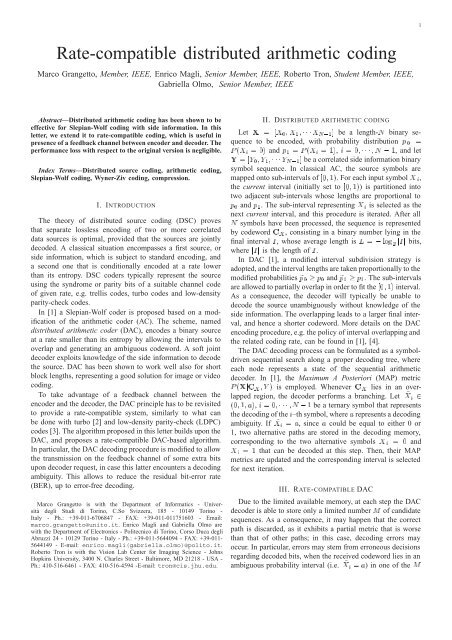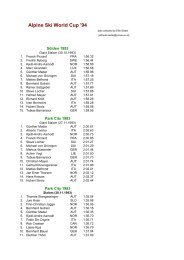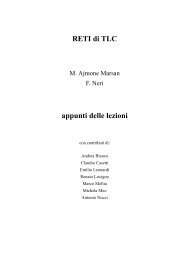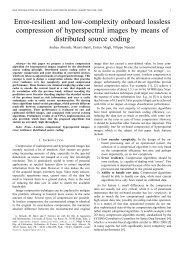Rate-compatible distributed arithmetic coding - Politecnico di Torino
Rate-compatible distributed arithmetic coding - Politecnico di Torino
Rate-compatible distributed arithmetic coding - Politecnico di Torino
Create successful ePaper yourself
Turn your PDF publications into a flip-book with our unique Google optimized e-Paper software.
1<strong>Rate</strong>-<strong>compatible</strong> <strong><strong>di</strong>stributed</strong> <strong>arithmetic</strong> <strong>co<strong>di</strong>ng</strong>Marco Grangetto, Member, IEEE, Enrico Magli, Senior Member, IEEE, Roberto Tron, Student Member, IEEE,Gabriella Olmo, Senior Member, IEEEAbstract—Distributed <strong>arithmetic</strong> <strong>co<strong>di</strong>ng</strong> has been shown to beeffective for Slepian-Wolf <strong>co<strong>di</strong>ng</strong> with side information. In thisletter, we extend it to rate-<strong>compatible</strong> <strong>co<strong>di</strong>ng</strong>, which is useful inpresence of a feedback channel between encoder and decoder. Theperformance loss with respect to the original version is negligible.Index Terms—Distributed source <strong>co<strong>di</strong>ng</strong>, <strong>arithmetic</strong> <strong>co<strong>di</strong>ng</strong>,Slepian-Wolf <strong>co<strong>di</strong>ng</strong>, Wyner-Ziv <strong>co<strong>di</strong>ng</strong>, compression.I. INTRODUCTIONThe theory of <strong><strong>di</strong>stributed</strong> source <strong>co<strong>di</strong>ng</strong> (DSC) provesthat separate lossless en<strong>co<strong>di</strong>ng</strong> of two or more correlateddata sources is optimal, provided that the sources are jointlydecoded. A classical situation encompasses a first source, orside information, which is subject to standard en<strong>co<strong>di</strong>ng</strong>, anda second one that is con<strong>di</strong>tionally encoded at a rate lowerthan its entropy. DSC coders typically represent the sourceusing the syndrome or parity bits of a suitable channel codeof given rate, e.g. trellis codes, turbo codes and low-densityparity-check codes.In [1] a Slepian-Wolf coder is proposed based on a mo<strong>di</strong>ficationof the <strong>arithmetic</strong> coder (AC). The scheme, named<strong><strong>di</strong>stributed</strong> <strong>arithmetic</strong> coder (DAC), encodes a binary sourceat a rate smaller than its entropy by allowing the intervals tooverlap and generating an ambiguous codeword. A soft jointdecoder exploits knowledge of the side information to decodethe source. DAC has been shown to work well also for shortblock lengths, representing a good solution for image or video<strong>co<strong>di</strong>ng</strong>.To take advantage of a feedback channel between theencoder and the decoder, the DAC principle has to be revisitedto provide a rate-<strong>compatible</strong> system, similarly to what canbe done with turbo [2] and low-density parity-check (LDPC)codes [3]. The algorithm proposed in this letter builds upon theDAC, and proposes a rate-<strong>compatible</strong> DAC-based algorithm.In particular, the DAC de<strong>co<strong>di</strong>ng</strong> procedure is mo<strong>di</strong>fied to allowthe transmission on the feedback channel of some extra bitsupon decoder request, in case this latter encounters a de<strong>co<strong>di</strong>ng</strong>ambiguity. This allows to reduce the residual bit-error rate(BER), up to error-free de<strong>co<strong>di</strong>ng</strong>.Marco Grangetto is with the Department of Informatics - Universitàdegli Stu<strong>di</strong> <strong>di</strong> <strong>Torino</strong>, C.So Svizzera, 185 - 10149 <strong>Torino</strong> -Italy - Ph.: +39-011-6706847 - FAX: +39-011-011751603 - Email:marco.grangetto@unito.it. Enrico Magli and Gabriella Olmo arewith the Department of Electronics - <strong>Politecnico</strong> <strong>di</strong> <strong>Torino</strong>, Corso Duca degliAbruzzi 24 - 10129 <strong>Torino</strong> - Italy - Ph.: +39-011-5644094 - FAX: +39-011-5644149 - E-mail: enrico.magli(gabriella.olmo)@polito.it.Roberto Tron is with the Vision Lab Center for Imaging Science - JohnsHopkins University, 3400 N. Charles Street - Baltimore, MD 21218 - USA -Ph.: 410-516-6461 - FAX: 410-516-4594 -E-mail: tron@cis.jhu.edu.II. DISTRIBUTED ARITHMETIC CODINGLet ¼ ½ ¡¡¡ Æ ½℄ be a length-Æ binary sequenceto be encoded, with probability <strong>di</strong>stribution Ô ¼ È ´ ¼µand Ô ½ È ´ ½µ, ¼ ¡¡¡Æ ½, and let ¼ ½ ¡¡¡ Æ ½℄ be a correlated side information binarysymbol sequence. In classical AC, the source symbols aremapped onto sub-intervals of ¼ ½µ. For each input symbol ,the current interval (initially set to ¼ ½µ) is partitioned intotwo adjacent sub-intervals whose lengths are proportional toÔ ¼ and Ô ½ . The sub-interval representing is selected as thenext current interval, and this procedure is iterated. After allÆ symbols have been processed, the sequence is representedby codeword , consisting in a binary number lying in thefinal interval Á, whose average length is Ä ÐÓ ¾ Á bits,where Á is the length of Á.In DAC [1], a mo<strong>di</strong>fied interval sub<strong>di</strong>vision strategy isadopted, and the interval lengths are taken proportionally to themo<strong>di</strong>fied probabilities Ô ¼ Ô ¼ and Ô ½ Ô ½ . The sub-intervalsare allowed to partially overlap in order to fit the ¼ ½µ interval.As a consequence, the decoder will typically be unable todecode the source unambiguously without knowledge of theside information. The overlapping leads to a larger final interval,and hence a shorter codeword. More details on the DACen<strong>co<strong>di</strong>ng</strong> procedure, e.g. the policy of interval overlapping andthe related <strong>co<strong>di</strong>ng</strong> rate, can be found in [1], [4].The DAC de<strong>co<strong>di</strong>ng</strong> process can be formulated as a symboldrivensequential search along a proper de<strong>co<strong>di</strong>ng</strong> tree, whereeach node represents a state of the sequential <strong>arithmetic</strong>decoder. In [1], the Maximum A Posteriori (MAP) metricÈ ´ µ is employed. Whenever lies in an overlappedregion, the decoder performs a branching. Let ¾´¼ ½µ, ¼ ¡¡¡Æ ½ be a ternary symbol that representsthe de<strong>co<strong>di</strong>ng</strong> of the –th symbol, where represents a de<strong>co<strong>di</strong>ng</strong>ambiguity. If , since could be equal to either 0 or1, two alternative paths are stored in the de<strong>co<strong>di</strong>ng</strong> memory,correspon<strong>di</strong>ng to the two alternative symbols ¼ and ½ that can be decoded at this step. Then, their MAPmetrics are updated and the correspon<strong>di</strong>ng interval is selectedfor next iteration.III. RATE-COMPATIBLE DACDue to the limited available memory, at each step the DACdecoder is able to store only a limited number Å of can<strong>di</strong>datesequences. As a consequence, it may happen that the correctpath is <strong>di</strong>scarded, as it exhibits a partial metric that is worsethan that of other paths; in this case, de<strong>co<strong>di</strong>ng</strong> errors mayoccur. In particular, errors may stem from erroneous decisionsregar<strong>di</strong>ng decoded bits, when the received codeword lies in anambiguous probability interval (i.e. ) in one of the Å
2active paths. In this situation, the de<strong>co<strong>di</strong>ng</strong> process may behelped if the encoder passes on to the decoder those bits thatturn out to be ambiguous during the de<strong>co<strong>di</strong>ng</strong> process (namedfeedback bits - FB). Upon detection of de<strong>co<strong>di</strong>ng</strong> failure, e.g.by using a cyclic redundancy check code, the decoder can haveone or more FBs sent over the feedback channel, and refineits first de<strong>co<strong>di</strong>ng</strong> attempt, possibly correcting the erroneouschoices. To this end, it is necessary that the encoder andthe decoder agree on a list of ambiguous symbols for whichFBs may be needed. The ambiguous symbols depend on both and . An explicit list would require a large amount ofextra rate, as well as explicit communication between and. On the other hand, the encoder can mimic the decoderoperations and create a list of the input symbols that willbe recognized as ambiguous by the decoder. In doing so, itexploits its knowledge of the original sequence, always takingcorrect decisions at branching nodes. This can be done inseveral ways; three options have been considered in this letter,namely: <strong>di</strong>rect ordering, inverse ordering, hybrid ordering.A. Direct ordering: encoderIn <strong>di</strong>rect ordering, the FBs are inserted in a list (called theFB list) following the normal forward ordering of the en<strong>co<strong>di</strong>ng</strong>and de<strong>co<strong>di</strong>ng</strong> procedures. The generation of the FB list ´µat the encoder, containing Ä bits, can be summarized asfollows.FB list generation (<strong>di</strong>rect ordering)- Encode the input sequence using DAC- Decode the obtained encoded sequencetaking correct decisions at branching points, as described below:- ¼- for ¼to Æ ½if ·½append to <strong>di</strong>rect FB list: ´µ end forIt is worth noticing that only the values of the FBs, not theirpositions, need to be transmitted to the decoder.B. Direct ordering: decoderWhen the decoder is unable to reconstruct the source usingthe received DAC codeword, FBs are extracted from the listand sent to the decoder upon request. With <strong>di</strong>rect ordering,the de<strong>co<strong>di</strong>ng</strong> operations are very simple. DAC de<strong>co<strong>di</strong>ng</strong> isperformed as usual; every time an ambiguous symbol isencountered, a FB is used to drive the correct de<strong>co<strong>di</strong>ng</strong> branch,until all the available FBs have been used; then, usual DACde<strong>co<strong>di</strong>ng</strong> is performed to deal with further branchings.However, it has been found that de<strong>co<strong>di</strong>ng</strong> errors tend tooccur mostly at the end of the sequence [4]. In fact, correctde<strong>co<strong>di</strong>ng</strong> happens because wrong paths that <strong>di</strong>verge from thecorrect one at the beginning of the sequence, are likely tobe <strong>di</strong>scarded, as the metric of the correct path asymptoticallytends to get dominant. Therefore, the <strong>di</strong>rect ordering is suboptimalin terms of ad<strong>di</strong>tional rate, in that the first transmittedFBs are less useful, as they do not refer to the most criticalbranches.C. Inverse ordering: encoderSen<strong>di</strong>ng the FBs in inverse order (i.e., starting from thosereferring to the last branching events) is more efficient if notall the FBs are transmitted, as these latter are more proneto de<strong>co<strong>di</strong>ng</strong> errors. The generation of the FB list in inverseorder Á ´µ, follows a procedure identical to <strong>di</strong>rect ordering,except that the bits are transmitted in inverse order, i.e. Á´µ ´Ä µ.D. Inverse ordering: decoderInverse ordering makes the decoder design more complex.In fact, it is possible that not all the Å sequences that areretained by the decoder stem from decoder branching decisionson ambiguous bits that match the transmitted FBs. In case asequence (i.e. a path) is not congruent with the FBs, it shouldbe removed from the decoder list, and another sequence,previously <strong>di</strong>sregarded due to the lack of de<strong>co<strong>di</strong>ng</strong> memory,should be resumed. In order to keep track of which sequenceshave been <strong>di</strong>scarded by the Å-algorithm and which ones donot match the FBs, it is necessary to store the whole de<strong>co<strong>di</strong>ng</strong>tree in the decoder memory. The mo<strong>di</strong>fied de<strong>co<strong>di</strong>ng</strong> processcan then be summarized as follows:1) Decode the whole sequence and store the whole de<strong>co<strong>di</strong>ng</strong>tree. At the end of the de<strong>co<strong>di</strong>ng</strong> procedure, the Åoutmost leaves of the de<strong>co<strong>di</strong>ng</strong> tree represent the set ofcan<strong>di</strong>date sequences, among which the one with the bestmetric will be selected.2) Backward-check the de<strong>co<strong>di</strong>ng</strong> tree using the FBs.3) Clear the de<strong>co<strong>di</strong>ng</strong> sequences that do not match the FBs.4) Revisit the de<strong>co<strong>di</strong>ng</strong> tree and resume already <strong>di</strong>scardedbranches.5) Select the sequence with the best de<strong>co<strong>di</strong>ng</strong> metric.The backward-check verifies if the sequences selected bythe decoder match the FBs at the branching points. As the FBsare transmitted in inverse order, it is necessary to scan thede<strong>co<strong>di</strong>ng</strong> tree from the leaves towards the root. Backwardcheckis implemented by means of a recursive procedure.Starting from a leaf of the tree, it is verified whether the branchlea<strong>di</strong>ng to that leaf matches the FBs. In case it does not, thatleaf must be pruned; otherwise, the control step moves onto the parent node, and so forth until all the FBs have beenscanned. In case a sequence is not compliant with the FBs, itis removed from the de<strong>co<strong>di</strong>ng</strong> memory, and the related leaf ispruned from the de<strong>co<strong>di</strong>ng</strong> tree.In order to make the memory management more efficient,and to speed up the algorithm execution, it is necessary tocancel those paths that have already been completely explored,and that cannot lead to de<strong>co<strong>di</strong>ng</strong> solutions <strong>compatible</strong> with theinformation contained in the FB list. This is done by means ofthe clearing step. It is a recursive procedure that visits eachnode in the tree. If both children nodes have already beenchecked, and do not match the FBs, that node is pruned fromthe tree. The branches are pruned progressively from the leavestowards the root, avoi<strong>di</strong>ng to prune any node that can lead tosolutions not already explored.In case one or more sequences have been cleared, sequencespreviously <strong>di</strong>scarded due to finite Å can be resumed. The
3restarting step visits the de<strong>co<strong>di</strong>ng</strong> tree in depth, and restoressome of those branches that had already been <strong>di</strong>scarded by theÅ-algorithm. The selection of the visiting order is done in agreedy manner, starting from the children nodes with bettermetric. When visiting a node whose children have not beenexplored yet, the de<strong>co<strong>di</strong>ng</strong> and the clearing passes are repeatedstarting from that node. After that, the visit of nodes for therestarting procedure continues recursively on the just createdpath. The procedure stops when all possible sequences havebeen verified, or the de<strong>co<strong>di</strong>ng</strong> memory is full.In order to terminate the de<strong>co<strong>di</strong>ng</strong>, all the solutions foundbefore and after the restarting step are compared, and that withthe best accumulated metric is selected as the final solution.As a final comment, it should be noted that, for both <strong>di</strong>rectand inverse ordering, correct de<strong>co<strong>di</strong>ng</strong> of the whole sequenceis ensured if all the FBs are transmitted and Ä is known atthe decoder.E. Hybrid orderingIn order to blend the advantages of the two <strong>di</strong>scussedapproaches, a hybrid ordering has also been considered. Thefirst à FBs are transmitted in inverse order, whereas the othersare transmitted in <strong>di</strong>rect order. In this way, a trade off betweenrate performance and de<strong>co<strong>di</strong>ng</strong> complexity can be achieved.The decoder starts with inverse ordering as long as it hasused the first à FBs. This yields a set of decoder statesthat are <strong>compatible</strong> with those FBs. Then, it uses the <strong>di</strong>rectordering de<strong>co<strong>di</strong>ng</strong> procedure, which selects one out of theavailable can<strong>di</strong>dates, identifying the decoder best path andhence allowing to output the decoded sequence.IV. EXPERIMENTAL RESULTSÆ samples of a binary memoryless source have beengenerated. The side information is obtained as the outputof a binary symmetric channel with input and transitionprobability Ô. In each simulation and for each data block, thesource data are compressed using DAC at a selected initialbase bit-rate, without using the FBs. Then, the FBs are usedone at a time, until the number of de<strong>co<strong>di</strong>ng</strong> errors for thatblock is zero. In all simulations the hybrid algorithm withà ½has been employed.Simulations have been run using 1000 blocks with Æ ½¼¼, Ô ¼ ¼, Ô ¼½½ (correspon<strong>di</strong>ng to À´µ ¼¼).Tab. I reports the average bit-rate for error-free de<strong>co<strong>di</strong>ng</strong>; notethat, unlike fixed-rate <strong>co<strong>di</strong>ng</strong>, these variable-rate simulationsconverge very quickly with a small number of trials. As canbe seen, it is convenient to take a base bit-rate that slightly exceedsthe Slepian-Wolf bound; in this case, error-free de<strong>co<strong>di</strong>ng</strong>is achieved at a rate about 0.07 bps larger than the bound. Forcomparison, a non rate-<strong>compatible</strong> DAC achieves error-freede<strong>co<strong>di</strong>ng</strong> at a rate equal to 0.58 bps. This is obtained averaging1000 trials in which each sequence is reencoded with DAC atincreasing rate up to error-free de<strong>co<strong>di</strong>ng</strong>; while this proceduredoes not represent a practical solution, it is a good benchmarkfor the rate-<strong>compatible</strong> algorithm. These results show that theperformance loss incurred for rate compatibility is negligible.Another simulation has been performed using 100 datablocks with Æ ¾¼¼, Ô ¼ ¼ and Ô ¼¾¿ (correspon<strong>di</strong>ngto À´µ ¼). Error-free de<strong>co<strong>di</strong>ng</strong> is achieved at a rateabout 0.06 bps larger than the bound. For comparison, the nonrate-<strong>compatible</strong> DAC achieves a rate of 0.61 bps.For the sake of comparison, we have also simulated a systembased on rate-<strong>compatible</strong> LDPC codes such as in [3], and onturbo codes such as in [2]. For the LDPC code, the only blocklength available in the software implementing [3] is Æ ¿.For the turbo code, we use block lengths of Æ ½¼¼ and Æ ¾¼¼ with S-random interleaving. For Ô ¼ ¼ and Ô ¼½½,the average bit-rate for error-free de<strong>co<strong>di</strong>ng</strong> turns out to be0.59 bps for irregular LDPC codes and 0.62 for regular codes.Under the same con<strong>di</strong>tions, the turbo code with Æ ½¼¼achieves 0.73 bps. For Æ ¾¼¼, Ô ¼ ¼ and Ô ¼¾¿, theirregular and regular LDPC codes achieve 0.67 and 0.69 bpsrespectively, while the turbo code achieves 0.99 bps; the poorperformance of turbo codes for asymmetric input <strong>di</strong>stributionhas also been noted in [4]. Hence, for small block lengths,the rate-<strong>compatible</strong> DAC outperforms turbo and LDPC codes.However, as noted in [4], unlike turbo and LDPC codes, theDAC performance does not improve significantly increasingthe block length.Table IAVERAGE BIT-RATE (BPS) NECESSARY FOR ERROR-FREE DECODINGBase bit-rate Average bit-rateÔ ¼ ¼, Ô ¼½½¼¾, Æ ½¼¼0.53 0.580.56 0.590.59 0.61Ô ¼ ¼, Ô ¼¾¿, Æ ¾¼¼0.57 0.640.61 0.62V. CONCLUSIONSIn this letter we have introduced a rate-<strong>compatible</strong> versionof DAC. It has been shown that the proposed algorithmoutperforms LDPC and turbo codes, and that the performanceloss of the rate-<strong>compatible</strong> with respect to the standard DACis negligible. This makes DAC suitable for applications wherea feedback channel is available for incremental transmissionof a source with side information is available at the decoder.REFERENCES[1] M. Grangetto, E. Magli, and G. Olmo, “Distributed <strong>arithmetic</strong> <strong>co<strong>di</strong>ng</strong>,”IEEE Communications Letters, vol. 11, no. 11, pp. 883–885, Nov. 2007.[2] B. Girod, A. Aaron, S. Rane, and D. Rebollo-Monedero, “Distributedvideo <strong>co<strong>di</strong>ng</strong>,” Procee<strong>di</strong>ngs of the IEEE, vol. Special Issue on Advancesin Video Co<strong>di</strong>ng and Delivery, no. 1, pp. 71–83, Jan. 2005.[3] D. Varodayan, A. Aaron, and B. Girod, “<strong>Rate</strong> adaptive codes for<strong><strong>di</strong>stributed</strong> source <strong>co<strong>di</strong>ng</strong>,” Signal Processing, vol. 86, no. 11, pp. 3123–3130, Nov. 2006.[4] M. Grangetto, E. Magli, and G. Olmo, “Distributed <strong>arithmetic</strong><strong>co<strong>di</strong>ng</strong> for the asymmetric slepian-wolf problem,” IEEE Transactionson Signal Processing (submitted), preprint available at URLwww1.tlc.polito.it/sas-ipl/Magli/index.php.






